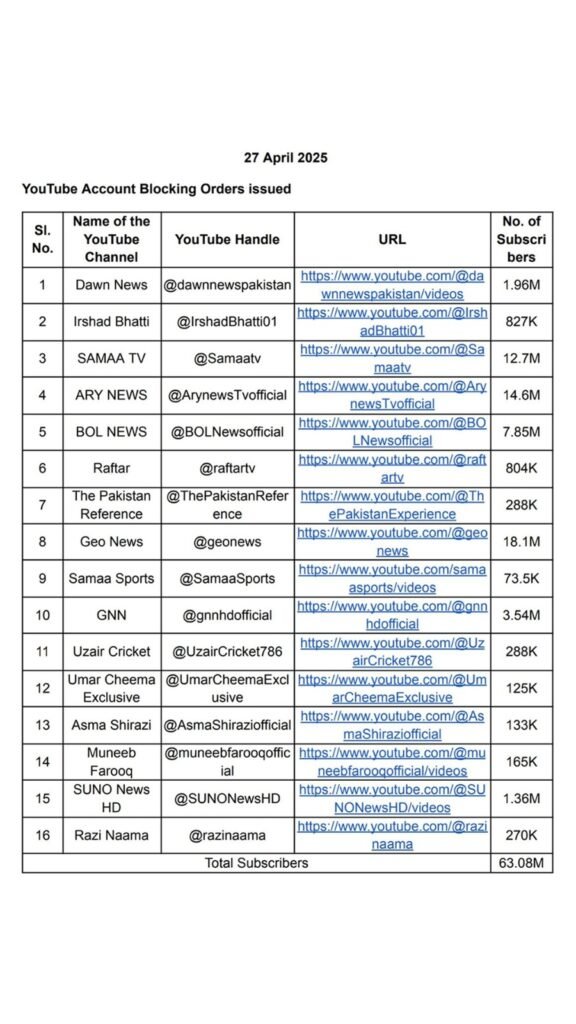In a bold move aimed at safeguarding national security, the government of India bans Pakistani YouTube channels, including some of the most influential ones like Shoaib Akhtar and Wasay Habib. This action comes in the wake of the devastating Pahalgam terror attack in Jammu and Kashmir, which claimed multiple lives. The ban on Pakistani YouTube channels is seen as a direct response to the growing concerns over cross-border terrorism and the spread of anti-India content.
India Bans Pakistani YouTube Channels: The Background
The tragic events of the Pahalgam attack, which took place on April 22, 2025, have intensified national security concerns. The attack targeted civilians, resulting in the deaths of 26 individuals and leaving many others injured. In light of the situation, the Indian government swiftly decided to block several Pakistani YouTube channels, accusing them of promoting anti-India rhetoric and spreading content that could incite violence.

By taking this step, India aims to prevent any further disruption to national peace and stability, especially amid ongoing tensions with Pakistan. The channels that have been banned are accused of disseminating provocative content, including inflammatory reports and videos, further exacerbating the political and social climate.
Channels Affected by the Ban
Among the numerous banned channels, some of the most well-known figures include former cricketer Shoaib Akhtar and media personalities like Wasay Habib. Their YouTube channels were immensely popular in India, with millions of viewers regularly tuning in for commentary, news, and discussions. However, after the Indian government imposed the ban, these channels are no longer accessible to Indian users.
The government’s decision is not limited to individual creators. Popular news channels like Dawn News, Samaa TV, ARY News, and Geo News have also been restricted, as they were often accused of broadcasting biased narratives about India. These Pakistani outlets have been critical of Indian policies, particularly with regard to Jammu and Kashmir, which has led to the ban.
National Security Concerns Behind the Ban
The primary reason cited for banning these Pakistani YouTube channels is the security threat posed by their content. Many of the blocked channels have been accused of fueling anti-India sentiment, spreading misinformation, and even glorifying violence. This is particularly concerning for a nation already on high alert after a series of terror attacks originating from Pakistan.

The Indian government’s move comes as part of a broader strategy to control the flow of content that could potentially harm national security. The country has faced criticism for taking such steps, especially from those who argue that the ban infringes on free speech and the free flow of information. However, India maintains that its national security must take precedence in the face of ongoing threats.
The Impact on Pakistani YouTubers and Their Indian Audience
The decision that India bans Pakistani YouTube channels has had a significant impact on the creators and their audiences. Pakistani influencers like Shoaib Akhtar, who is a household name in India due to his cricketing career, have lost access to millions of Indian subscribers. Likewise, Wasay Habib, known for his witty commentary and insights on current events, now faces the challenge of adapting to this ban.
For their Indian viewers, the ban represents a sudden disruption to the content they’ve enjoyed for years. The blocked channels have cultivated loyal followings, and many Indian viewers are now left without access to their favorite creators. The situation has sparked debates on social media platforms, where some support the government’s decision, while others argue it’s an overreach.
The Political and Diplomatic Dimensions of the Ban
This move by India has not only raised questions about media freedom but has also escalated the already tense diplomatic relations between India and Pakistan. India bans Pakistani YouTube channels comes at a time when both countries are engaged in a delicate geopolitical balance, and such decisions can strain relations further.
Many critics argue that this measure could impact peace-building efforts, especially when cross-border communication is limited. However, the Indian government stands firm on its position, emphasizing that security concerns must come first, particularly in the context of terrorism.
A Strategic Move in the Digital Age
In the age of digital communication, the decision that India bans Pakistani YouTube channels is a reflection of how modern technology can both connect and divide nations. As the global media landscape continues to evolve, governments are increasingly taking steps to regulate online content that they deem harmful to national interests.
While India bans Pakistani YouTube channels may be controversial, it underscores the importance of protecting national security in an interconnected world. As tensions between India and Pakistan remain high, the Indian government’s actions reflect its commitment to ensuring the safety and well-being of its citizens, even in the realm of digital media.
Also Read: NASA-ISRO’s NISAR Project Reaches Milestone with the Arrival of Radar Antenna Reflector at Bengaluru












